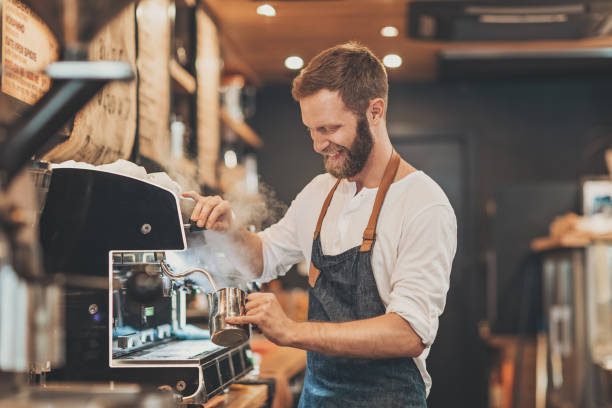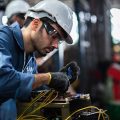| Barista Key Stats | |
|---|---|
| Avg. Salary / year | $37,310 |
| Avg. Pay / hour | $17.94 |
| Education | 0-6 Months |
| Job Outlook | 14% |
| Total Employed | 448,260 |
A Barista is the “bartender” of coffee drinks and uses their vast knowledge of espresso and coffee to make the sleepy perk up and become morning people.
Barista is actually the Italian word for bartender and these professionals use their knowledge and skills in order to brew a variety of coffee drinks including lattes, cappuccinos and espressos.
A Barista can work for a specialty coffee shop, hotel, fine dining restaurants or in airports making sure people get their daily doses of caffeine.
These workers mainly stat behind a restaurant counter taking orders and making drinks within minutes.
Go to Page Section:
Education Requirements to Become a Barista
There are a handful of programs that offer the necessary training in order to become a Barista .
However, most candidates can find a job in this field and gain experience with on the job training.
Employment opportunities will vary depending on the employer.
Some employers require a minimum of a high school diploma or sometimes even less education.
Candidates who want to become a Barista should have thorough knowledge on how to make a variety of coffee or similar drinks.
The following skills are necessary in order to succeed in this profession:
- Grinding coffee beans
- Knowing the various types of coffee drinks that can be made using espresso
- Steam milk for cappuccinos or lattes
- Using several kinds of equipment to grind coffee, steam milk and make espresso
Candidates who want to join this field can opt to join a professional Barista training program in order to become a highly qualified candidate.
Some training programs can be offered online.
However, most employers seek candidates with an innate set of skills and the ability to be trained on the job.
Getting trained on the job is also a cheaper way to get your foot into this growing industry.
The following characteristics are often sought by hiring employers:
- Multitasking: ability to handle several requests at once
- Communication: Able to handle requests from other staff and customers
- Technology: Ability to use equipment to make espresso drinks and use POS register systems
- Physical: Be able to work on your feet for extended periods of time
- Food handling: Have the ability to handle hot food and beverages
Barista Job Description
Some Baristas have to get up early in the morning as some specialty coffee shops open their doors in the early hours of the morning.
They are responsible for grinding coffee beans to prepare for espresso, the main ingredient in popular drinks such as cappuccinos, Lattes and Americanos.
Once an order is placed, Baristas will have to work fast making sure the drinks are made to perfection.
After receiving a verbal order from a colleague stationed at the counter, a Barista will begin brewing espresso to perfection.
If the business is busy, Baristas will have to brew espresso drinks within minutes in order to satisfy customers.
The second step in making an espresso drink is heating the milk.
Cappuccinos require high skills because of the foam needed to be created from milk.
A Barista will also have additional duties such as replenishing espresso and other coffee drinks ingredients.
They will need to keep their station clean and wash all the dishes they use to prepare drinks.
Barista Salary and Career Path
The exact wage and salary for a full time Barista will depend on several factors, including the type of business they work for.
For example, Baristas can work for coffee shops that specialize in making only coffee drinks, in full service restaurants or the travel accommodation sector.
The Bureau of Labor Statistics reports that Baristas working in these industries made a median wage of $9.43 per hour in the year 2008.
The wage range for these workers during the same year was approximately $7.58 to $12.32 per hour worked.
The report doesn’t state whether these figures include tips which are commonplace in the service industry.
Employment figures for Baristas strongly depend on how well the economy is doing.
The Bureau of Labor Statistics reports that there will be an average growth of 10 percent through the year 2018 for these professionals.
Job opportunities for food and beverage workers will be vast during this time with an estimated 761,000 new job opportunities, the largest in any field.
Candidates looking to become a Barista should expect to find more competition in fine dining and popular restaurants.
![]() The below information is based on the 2024 BLS national averages.
The below information is based on the 2024 BLS national averages.
National Average Salary
$37,310Average Salary by State
| State | Avg. Annual Salary |
|---|---|
| Alabama | $26,910 |
| Alaska | $48,410 |
| Arizona | $40,890 |
| Arkansas | $31,160 |
| California | $47,060 |
| Connecticut | $46,640 |
| Delaware | $42,020 |
| District of Columbia | $45,790 |
| Florida | $36,600 |
| Georgia | $34,720 |
| Hawaii | $50,250 |
| Idaho | $33,890 |
| Illinois | $38,050 |
| Indiana | $34,480 |
| Iowa | $33,580 |
| Kansas | $31,930 |
| Kentucky | $32,300 |
| Louisiana | $27,580 |
| Maine | $41,250 |
| Maryland | $41,130 |
| Massachusetts | $47,100 |
| Michigan | $35,910 |
| Minnesota | $42,340 |
| Mississippi | $27,190 |
| Missouri | $33,470 |
| Montana | $37,340 |
| Nebraska | $36,290 |
| Nevada | $40,150 |
| New Hampshire | $44,260 |
| New Jersey | $43,670 |
| New Mexico | $34,460 |
| New York | $46,050 |
| North Carolina | $34,380 |
| North Dakota | $40,080 |
| Ohio | $35,970 |
| Oklahoma | $29,190 |
| Oregon | $43,320 |
| Pennsylvania | $36,800 |
| Rhode Island | $44,960 |
| South Carolina | $31,830 |
| South Dakota | $35,790 |
| Tennessee | $33,260 |
| Texas | $33,020 |
| Utah | $38,680 |
| Vermont | $42,160 |
| Virginia | $37,640 |
| Washington | $49,920 |
| West Virginia | $30,700 |
| Wisconsin | $39,000 |
| Wyoming | $36,180 |
| Guam | $30,910 |
| Puerto Rico | $26,470 |
| Virgin Islands | $30,640 |
The highest-paying state in this field is Hawaii, with an average salary of $50,250.
Here are the five states with the highest salaries in the field:
* Employment conditions in your area may vary.
Frequently Asked Questions
What is a barista?
Baristas work in coffee bars and serve beverages, such as tea and coffee.
They can also serve sandwiches and cookies.
In order to be a good barista, you need good communication and customer-serving skills, physical stamina and the strength to spend most of your time standing.
Baristas have to be able to work in a busy environment and to keep their calm while completing multiple tasks at the same time.
How much does a barista make?
According to the Bureau of Labor Statistics, the median hourly wage for food and beverage serving and related workers was $10,45 in May 2018.
The hourly wage varies depending on the field of employment.
Counter attendants and those working in cafeterias and coffee shops earned a median hourly wage of $10.74.
Baristas often work part-time; restaurant business hours give employees the possibility of choosing between flexible schedules which appeal to students and teenagers.
Many beginning workers in the food and beverage serving field earn the minimum wage.
Some baristas also earn tips.
Employers may provide meals and uniforms but some of them deduct the cost from the employee’s salary.
How much does it cost to become a barista?
There are no specific education requirements for this profession; most baristas receive on-the-job training for several weeks.
Some employers train their employees through instructional videos, booklets, and audiovisual presentations, but most food and beverage serving workers learn from their more experienced co-workers.
In some cases, new employees also receive classroom training designed to help them get to know the rest of the staff and to teach them about the restaurant’s philosophy and formal serving techniques.
If you want to get better employment prospects you can also enroll in a certificate program offered by a training institution.
Barista classes usually are between $100-$1000, but the exact costs vary depending on the school you choose and the length of the program.
What is the demand for baristas?
According to the Bureau of Labor Statistics, the employment for food and beverage serving and related workers is expected to grow 14 percent from 2018 to 2028.
As the number of people who dine out continues to grow, more restaurants are expected to open and more workers will be needed to serve customers.
Also, many job openings appear each year because of workers who leave the profession.
How long does it take to become a barista?
There are no formal education requirements for those who want to become baristas.
In most cases, they learn through several weeks of on-the-job training.
In order to receive experience and to learn the skills you need to succeed in this field, you can start by getting a job in a coffee bar as a server or junior coffee maker and learn from an experienced barista.
If you want to learn coffee making skills you can also enroll in a certificate program offered by a training institution.
These types of training programs range from one day to 15 weeks.
Most schools don’t have admission requirements for their barista programs.













